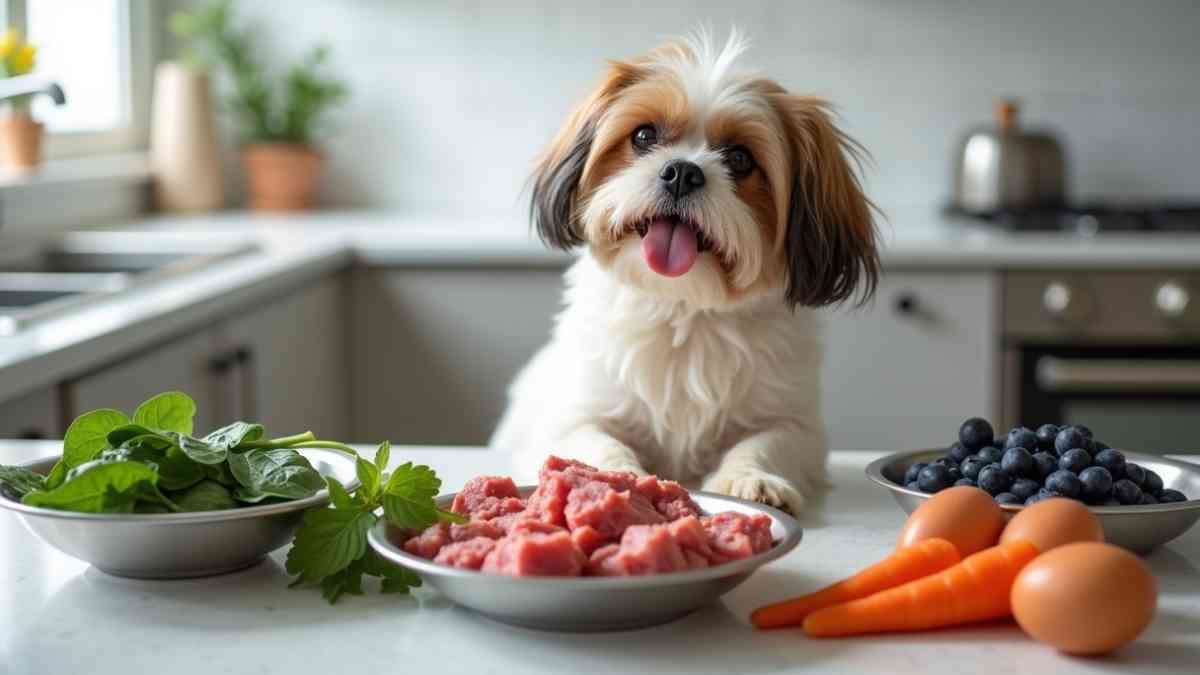Raw Food Diet for Shih Tzu: Is It Safe and How to Start?

Feeding your Shih Tzu a raw food diet is more than a trend—it’s a rising lifestyle shift among devoted dog owners who want to bring their pets closer to their natural roots. For the Shih Tzu, a breed known for its charming personality, luxurious coat, and delicate digestive system, introducing raw food can be both beneficial and tricky if done without proper guidance.
Understanding the Raw Food Concept
The term “raw food for Shih Tzu” refers to a biologically appropriate diet that includes uncooked meat, bones, organs, fruits, and vegetables. Commonly known as the BARF diet (Biologically Appropriate Raw Food), it mimics what wild canines eat, offering a more ancestral approach to nutrition. Rather than processed kibble, the focus shifts to whole foods with minimal intervention.
Why Shih Tzu Owners Are Considering Raw
With increased awareness of the ingredients in commercial dog foods, many owners are seeking healthier alternatives. Shih Tzus, in particular, are prone to allergies, digestive issues, and weight problems. Feeding raw allows owners to control every ingredient, potentially eliminating common triggers like grains, artificial preservatives, and additives.
What’s Included in a Raw Food Diet
A balanced raw meal typically contains 70% muscle meat, 10% edible bone, 10% organs, and the remaining 10% from vegetables, fruits, and supplements. The protein source can vary—chicken, turkey, beef, lamb, or even fish. Supporting ingredients like pumpkin, spinach, blueberries, and kefir provide additional nutrients and aid digestion.
The Benefits of Feeding Raw
One of the most immediate changes seen after switching to raw is a shinier, healthier coat. The high levels of natural fats and proteins nourish the skin and fur. Dogs also tend to have better oral hygiene, thanks to the mechanical cleaning effect of chewing raw meaty bones.
Owners often report smaller, firmer stools, fewer ear infections, and reduced allergy symptoms. This is because raw food is highly digestible, leaving little waste and minimizing inflammatory reactions. Many also notice increased energy levels and a more consistent appetite, particularly in picky eaters.
Potential Risks of Raw Feeding
While raw feeding has clear upsides, it’s not without its risks. Improper balance of calcium and phosphorus can lead to skeletal issues. Contamination with bacteria like Salmonella or E. coli is a valid concern if hygiene isn’t maintained.
Another risk is choking or internal injury from hard bones, especially if bones are too large or not appropriately matched to your Shih Tzu’s size. Lastly, feeding raw without understanding your dog’s individual health conditions could lead to unintended complications.
Is Raw Food Safe for Your Shih Tzu?
Yes, it can be—but it must be approached responsibly. Veterinary approval is essential, especially if your Shih Tzu has underlying issues such as kidney disease, pancreatitis, or immune suppression. Many holistic vets support raw feeding, provided it is balanced and hygienically prepared.
How to Start the Raw Food Journey
Begin by selecting one protein source, such as chicken. Feed it exclusively for about a week and monitor for changes. Then, gradually introduce organ meats, followed by edible bones, and later add vegetables and fruits. Keep portion sizes to about 2-3% of your dog’s ideal body weight per day.
Freeze meats before feeding to kill parasites, and always prepare food in a clean area. Store leftovers in sealed containers and wash your hands and utensils thoroughly.
Safe Ingredients to Include
- Chicken, turkey, beef, lamb, venison
- Liver, kidney, spleen (in moderation)
- Spinach, kale, carrots, pumpkin
- Apples, blueberries, banana (no seeds)
- Eggs (with shell), plain yogurt, kefir
- Fish oil, vitamin E, probiotics (as needed)
What to Avoid
Never feed cooked bones—they splinter easily and can cause internal damage. Onions, garlic, chocolate, grapes, and raisins are toxic. Also avoid feeding too much liver or only muscle meat without bones or organs.
Feeding Guidelines and Quantities
An adult Shih Tzu usually weighs between 4 and 7 kg. A healthy raw diet for this size ranges from 80g to 140g per day, depending on activity level and age. Puppies may need up to 10% of their body weight, while seniors may require less.
Divide meals into two daily servings to avoid bloating and stabilize energy levels. Adjust based on body condition—if your Shih Tzu is gaining weight, cut back slightly; if underweight, increase portions moderately.
Food Handling and Hygiene
Treat your dog’s raw meals the same way you would treat raw meat in your kitchen. Wash surfaces, bowls, and your hands with soap and warm water after preparation. Store food in the fridge for no more than 3 days or freeze for longer preservation.
Use stainless steel or ceramic bowls rather than plastic, which can harbor bacteria. Defrost meals in the refrigerator—never at room temperature.
Cost and Convenience Considerations
Feeding raw may appear expensive, but costs can be managed by buying in bulk, using local butchers, and including affordable ingredients like chicken backs, organs, or seasonal produce. Pre-made raw diets are available but can be pricier.
Meal prepping for the week in advance saves time. Many raw feeders report that, over time, the vet savings from fewer health issues offset the cost of raw ingredients.
What to Watch After Switching
Positive signs include more energy, improved coat, normal stools, and fewer allergy flare-ups. Red flags might be diarrhea, vomiting, loss of appetite, or lethargy. Any of these warrant a vet check and diet adjustment.
Weigh your dog weekly during the first month and track how their body responds. It’s important not to overcorrect minor changes too quickly.
Common Myths Around Raw Feeding
“Dogs will become aggressive after eating raw meat” is a myth. Raw food does not change your Shih Tzu’s personality. Another false belief is that kibble is always complete while raw isn’t—in truth, both can be balanced or poorly done depending on the execution.
“Dogs can’t digest bones” is also misleading. Raw bones are digestible; cooked bones are dangerous. Always supervise your dog while eating bones.
Conclusion
Choosing a raw food diet for your Shih Tzu is a serious but rewarding commitment. Done properly, it can enhance your dog’s life in visible and measurable ways. But success lies in education, consistency, and observation. Don’t rush the process. Plan meals carefully, keep hygiene in check, and consult your vet throughout the journey.
Feeding raw isn’t just about diet—it’s about honoring the natural instincts of your dog and providing a foundation for lifelong health.
Start your Shih Tzu’s raw food journey today—for a healthier, happier life!




